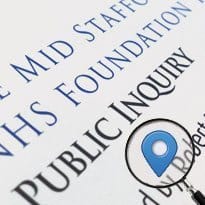Govt plans law to stop “fiddled” figures
- 16 March 2013

The government is thinking of holding trusts criminally liable for manipulating figures on waiting times and death rates as part of its response to Robert Francis’ final report into the scandal at Mid Staffordshire NHS Foundation Trust.
According to a report in the Daily Telegraph, health secretary Jeremy Hunt is inclined to introduce new criminal sanctions to support Francis’ call for more transparency in the health service, and in response to a spate of newspaper stories claiming that trusts have “fiddled” their mortality figures.
The paper says that “a source close to” Hunt told it that “the manipulation of data has been happening, rarely but consistently, for many years. We feel strongly that if NHS trusts are caught acting fraudulently about their performance on areas such as death rates or waiting times they should be criminally liable.”
It adds that the government’s response, which is expected by the end of the month, will require hospitals to publish “patient relevant data.”
It also said that the government was minded to back Francis’ demand for a new criminal offence of “giving deliberately misleading information to the public and regulators” and that there would be new routes for whistleblowers to raise concerns about the data released.
Francis has published two reports on Mid Staffs. The first, published in 2010, showed that the trust had persistently high death rates and very poor care in the A&E department and some wards at Stafford Hospital.
The second report, published in February, looked at why the problems had persisted for as long as they did.
It called for new fundamental standards to be created for the NHS, underpinned by legal sanctions for failing to meet them, and for a culture change among NHS staff, underpinned by the new duty of candour and the “open and honest” publication of more data for regulators, managers, clinical staff and patients.
Following the publication of the report, NHS medical director Sir Bruce Keogh has announced that he will investigate 14 trusts with persistently high death rates, as measured by the Hospital Standardised Mortality Ratio and the Summary Hospital-level Mortality Indicator.
The SHMI was introduced in the wake of the first Francis inquiry, which questioned why there were different mortality ratios in use in the NHS and why different organisations disagreed about their interpretation.
Mid Staffs appeared as an outlier on the HSMR in 2007, but there was initially a debate about whether it had a coding or a real problem.
Sir Bruce’s inquiry has led to a number of press reports claiming that high death rates have been ignored and that some hospitals have been “fiddling” their figures.
Sir Brian Jarman, the head of the Dr Foster Unit at Imperial College, London, which helped to raise the alarm at Mid Staffs, told the BBC on Saturday that as many as 20,000 excess deaths had occurred because the Department of Health and regulators had failed to act on its HSMR figures.
Meanwhile, two trusts – Bolton Hospitals and Royal Wolverhampton Hospitals – have faced accusations this month that they manipulated their HSMR figures.
The chief executive of the first trust “stepped aside” after an audit found it might have coded more patients than warranted as dying of septicaemia. The management of the second has vigorously denied claims in the Daily Mail that it brought in a coder to massage its data.
Despite the intense public focus on the issue of mortality rates, some responses to Francis are starting to warn that they are hard to interpret, that they can only raise the alarm when things have gone very wrong, and that more sources of data are needed to spot issues at ward and individual level.
This week, the Nuffield Trust urged the government to avoid taking a “big stick” approach in its response, and to consider carefully how to support new measures of assessment with data.



